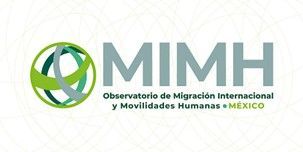
International Migration and Human Mobility Observatory -Some interesting facts-
The International Migration Observatory (IMO) was created in response to the information needs of the National Population Programs in relation to international migration, which affects population dynamics.
In different phases of the initial process of formation and consolidation of the Observatory, the collaborative work with representatives of academic institutions (El Colegio de México, El Colegio de la Frontera Norte, Instituto Mora, UNAM, El Colegio de la Frontera Sur, Universidad Iberoamericana, Instituto Tecnológico Autónomo de México), governmental institutions (Secretaría del Trabajo, Ministry of Foreign Affairs, National Migration Institute, Migration Policy Unit, Ministry of Health), civil society organizations (Red de Documentación de las Organizaciones Defensoras de Migrantes, Red de Fortalecimiento Humanitario), and international organizations (United Nations Population Fund, International Organization for Migration, Economic Commission for Latin America and the Caribbean); and private institutions (Bancomer and BBVA Foundation).
Currently, OMI's objectives are:
- To build up an updated statistical collection on migration with origin, destination, transit and return in Mexico.
- To promote and develop, in collaboration with public and academic institutions and experts, the elaboration of studies on the different dimensions of the migration phenomenon that guide and strengthen the actions and strategies proposed by the population policy.
- To publish and disseminate relevant studies on the subject.
- To disseminate relevant news on international migration, as well as information on events and calls on the subject.
It is made up of five sections: "Publications", "Statistics", "Infographics", "Migratory miscellany", and "News, events and announcements".
Summary of selected articles (to view the article in its original site, click on the title).
International and national instruments for the protection of migrant children and adolescents.
This issue of Migratory Signals takes a look at the international, regional and national instruments that protect and guarantee the rights of children and adolescents, particularly those who, for various reasons, form part of the international migrant population. Throughout the text, the relevance of the human rights of migrant children is recognized, especially the large numbers that account for them.
Diagnosis of the situation of return migration in Mexico.
This paper presents a summary of the reflections of the “Diagnosis” document of Component F on “Return Migration in Mexico”, which deals with the return and repatriated populations in Mexico, identifying quantitative aspects of these. To a large extent, it is a preamble to the analysis of policies and programs aimed at influencing the reintegration of these populations at the national level, under the proposal of “sustainable reintegration”. In light of the different experiences of international public policy, the “Diagnosis” proposes several courses of action and/or strategies that could be useful in Mexico for the care of the returning and repatriated migrant population.
Based on the analysis of quantitative elements from robust sources of information, it gives an account of the arrests and the demographic change in the population of northern Central America residing in the United States. Strictly speaking, statistical figures that serve as a heuristic tool to address part of the field of current academic and political reflection in US society on international immigration to its territory, with an emphasis on the issue of identity and value systems, which offers paradoxes that are difficult to resolve in the realm of everyday life and public policy.
Central American migration to the United States and exploration of proposed solutions.
The article “Being an immigrant, woman, mother and worker in Mexico” by the National Population Council highlights the importance and challenges of immigrant women in Mexico. Some of the key data provided are: 1) Population: there are more than half a million immigrant women in Mexico, of whom approximately one third are mothers. 2) Origin: the majority of these women come from the United States (35%) and Central and South America (46%). 3) Age: the median age of immigrant mothers is 40. 4) Residence: they prefer to live in large cities, with the main regions of residence being North, Central and South-Southeast Mexico. 5) Employment: approximately 38% of immigrant mothers are employed, with the main occupations being in sales and services, scientific and intellectual professions, and administrative support. // The article highlights the challenges these women face in balancing their roles as mothers and workers, and the importance of recognizing their contribution to Mexican society.
This paper summarizes part of the specialized literature that has been reporting for more than three decades how environmental degradation and climate change lead to human mobility, particularly in what is often called international migration. This topic is recognized as highly complex in the pioneering works of Brown (1976), El-Hinnawi (1985) and Jakobson (1988), through the category of “ecological refugees” or “environmental refugees”; in all three cases, despite the thematic proximity, there are important differences such as the pressure on resources in the areas of refuge compared to environmental conditions that are perceived as adverse to life, or the anchoring of the issue of human mobility to a perspective of humanity's abuse of the earth and in relation to climate threats. Likewise, academic articles and articles from international organizations are included, highlighting the most relevant points that they have collected on the subject, and an approximation for the case of the classification of drought, one of the main slow-evolving meteorological phenomena associated with climate change in municipalities with a high and very high degree of migratory intensity between Mexico and the United States for 2000, 2010 and 2020.
Conceptual elements around the social immigration of the international immigrant population.
The study is based on an analytical proposal around the category of “foreigner”. To this end, it takes a brief look at some of the most common meanings used in various studies on the presence of those who were not born in the country in which they reside. Based on this idea, a reflection is made on nationality and citizenship, and with it on the guarantee and exercise of the human rights of migrant populations on an international scale, with respect to which there is in the current dialogue between various disciplines the question of whether elements within globalization are identified that indicate the existence of a global citizenship or whether within it the national states endure and strengthen their internal legislation in accordance with the proposals of international organizations.
The phenomenon of migrant caravans in Mexican territory (2023).
Within human mobility, migrant caravans refer to a journey from an origin to a destination, as an individual and collective strategy. Here they are defined as a form of mobility that uses public and private resources, where there is a migratory tradition in the space involved, and in which this mobility is made visible. It is emphasized that a caravan must be: 1) a vector of resources, 2) a flow of people using this vector, 3) the existence of a country of expulsion where the State is weak in that it does not offer welfare to those who migrate, 4) the existence of a transit country and an attractive country where the salary for the same work or the welfare State is higher, and 5) an administrative logic of migratory documentation. Then, the antecedents of these are compared as part of the repertoires of social protest in the Central American region and in the Mexican south-southeast. Their migratory route in 2022 is also addressed, and some of the obstacles that make it difficult to follow them are noted. It is concluded that the caravans are a collective capacity; and it is observed that this capacity is echoed in the Montevideo Consensus on Population and Development and the Global Compact for Safe, Orderly and Regular Migration.
Mexican people, households and families in the United States [infographic].
The infographic offers key information on the composition and demographic structure of households headed by Mexicans and their migratory dynamics.
Mexico-United States migration intensity indices 2020.
In this context, a balance is presented of Mexican migration to the United States, return migration from that country and transit migration through our territory. It uses primary sources of information, has a statistical focus and frames the migratory phenomenon in historical, economic and political-legislative events. With regard to Mexican migration to the United States, emphasis is placed on the tightening of entry policies by the various governments of that country, which suggests that this is a long-term state policy; with regard to return migration, the emphasis is on its intermittence during the 21st century; and with regard to transit migration, the emphasis is on how it has evolved during the pandemic.
Being an immigrant, a woman, a mother and a worker in Mexico.
The article “Being an immigrant, woman, mother and worker in Mexico” by the National Population Council highlights the importance and challenges of immigrant women in Mexico. Some of the key data provided are: 1) Population: there are more than half a million immigrant women in Mexico, of whom approximately one third are mothers. 2) Origin: the majority of these women come from the United States (35%) and Central and South America (46%). 3) Age: the median age of immigrant mothers is 40. 4) Residence: they prefer to live in large cities, with the main regions of residence being North, Central and South-Southeast Mexico. 5) Employment: approximately 38% of immigrant mothers are employed, with the main occupations being in sales and services, scientific and intellectual professions, and administrative support. // The article highlights the challenges these women face in balancing their roles as mothers and workers, and the importance of recognizing their contribution to Mexican society.
